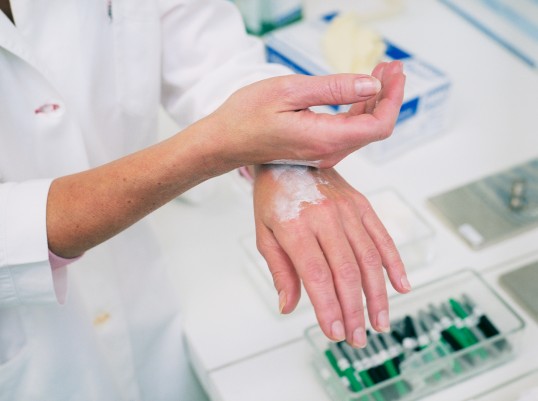Skin hazards and skin protection - Prevention strategies

Source: © Wolfgang Bellwinkel / DGUV
The skin is the body’s largest organ, and its outer layer represents a barrier against external mechanical, physical and chemical influences. When the skin comes into contact or interacts with working agents there is a risk of overwhelming that barrier in a way which can lead to skin disease, lasting skin damage or amplified allergic reactions.
Documentation of occupational diseases in Germany demonstrates that a quarter of all reported cases of suspected occupational diseases and a third of all confirmed occupational diseases are attributable to skin disease. In many cases this is accompanied by serious personal, social and economic implications which have an impact on affected persons, companies and the German social accident insurance institutions.
Cleaning agents, solvents, cement, metals, cooling lubricants, adhesives, substances contained in rubber, disinfectants, work in damp environments and the use of impermeable protective gloves in the workplace for long periods (occlusion) are often the cause of occupational skin diseases. Skin diseases can be dealt with effectively using preventive measures. If applied consistently, such measures can reduce or even prevent serious and chronic skin diseases (e.g. allergies or eczema).
In addition to a thorough risk assessment, the most important measures include reducing contact between the skin and hazardous substances in the workplace (e.g. by modifying work processes, substituting hazardous substances or implementing technical solutions) and ensuring the consistent use of appropriate hand and skin protection. Clarification and the dissemination of information also have a key role to play, and can be used to make employees aware of potential skin damage and motivate them to change their behaviour when handling working agents which represent a skin hazard.
The newly formulated "Technical Rule for Hazardous Substances 401: Risks resulting from skin contact – identification, assessment, measures" (TRGS 401) puts the requirements and statements on skin-affecting activities included in the German Ordinance on Hazardous Substances (GefStV) into concrete terms. TRGS 401 provides guidelines on information gathering and risk assessment in the workplace, and supports companies in defining protective measures, organizing occupational medical prophylaxis and evaluating tenders received from providers thereof. The appendix to TRGS 401 includes links to a range of sector-specific guidelines published by the German social accident insurance institutions and governmental departments with OSH responsibility.
The exposure of the skin to UV radiation in the workplace can also lead to conditions ranging from erythema (sunburn), phototoxic or photoallergenic reactions and chronic light damage to skin cancer. Increased exposure to UV radiation is a particular issue for employees who work outdoors, with UV paint and lacquer drying systems, with reactive adhesives, with welding or cutting equipment, with disinfectants or in the field of material fault visualization. Enclosed systems should be used in order to minimize exposure to radiation. Suitable personal protective equipment (PPE) comes in the form of UV-impermeable glasses, clothing and sunscreen. Employees should be informed about the danger of optical radiation and given instructions on the implementation of protective measures.
Contact

Karina Weinert
Safety and Health Department
Unit health protection
Tel.: +49 30 13001-4556
E-Mail
Prof Dr Manigé Fartasch
Institute for Prevention and Occupational Medicine of the German Social Accident Insurance (IPA)
Center of Medicine
Clinical & Experimental Occupational Dermatology
Tel.: +49 30 13001-4140
E-Mail